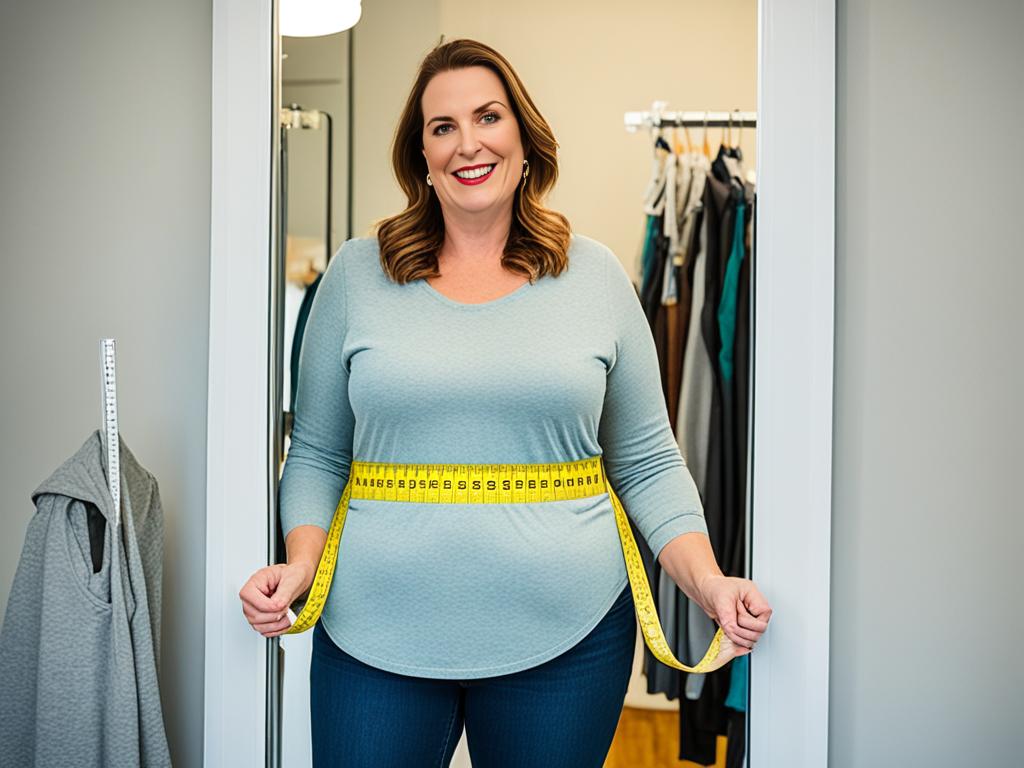Are you tired of struggling to find the perfect fit when shopping for pants? Do you often end up with pants that are too tight, too loose, or just not quite right? If so, you’re not alone. Many people struggle with determining their pant size and often rely on guesswork or trial and error.
But what if there was a foolproof way to measure your pant size accurately? A method that would ensure a perfect fit every time you shop for pants? Well, you’re in luck! We have the answers you’ve been searching for.
In this comprehensive guide, we will show you step-by-step how to measure your pant size like a pro. Whether you’re a man or a woman, we’ve got you covered. From measuring your waist to finding the right inseam length, we’ll leave no stone unturned in our quest to help you find the perfect pair of pants.
Key Takeaways
- Accurately measuring your pant size is essential for finding the perfect fit.
- Measure your waist and inseam to determine your pant size.
- Consider the rise and style of the pants to find a comfortable and flattering fit.
- Consult a pant size chart and try on different sizes to find the best fit for you.
- Don’t be afraid to size up or down to find the right fit for your body type.
How to Measure Pant Size?
Tips for Measuring Pant Size for Men
When it comes to finding the perfect fit, measuring your pant size accurately is crucial. To ensure you get the right measurements, follow these tips for measuring pant size for men:
- Measuring the Waist: Use a soft measuring tape to measure your waist at the smallest part, which is generally just above your belly button. Make sure the tape is snug but not tight to get an accurate measurement.
- Measuring the Inseam: For the inseam measurement, place the measuring tape at the top of the inside of your leg and take it down to your ankle bone. This will give you the proper length to look for when buying pants.
- Remove Your Shoes: To get the most accurate measurement, make sure to measure your waist and inseam with your shoes off. This helps eliminate any discrepancies caused by shoes adding extra height.
By following these measurement guidelines, you can confidently find pants that fit perfectly. Remember, different brands may have slight variations in sizing, so it’s always a good idea to try on pants before making a purchase. Additionally, consult the store’s size chart to match your measurements to the most appropriate size range.
Tips for Measuring Pant Size for Women
Measuring pant size for women follows similar guidelines as men. Start by measuring your waist at the smallest part, either above your belly button for high-waisted pants or closer to your hips for low-rise pants. Use a soft measuring tape and make sure it is snug but not tight. For the inseam measurement, place the tape at the top of the inside of your leg and take it down to your ankle bone. This will give you the proper length for your pants. Remember to measure with your shoes off for the most accurate result.
Importance of Properly Measuring Pant Size

Knowing how to determine your pant size accurately is crucial in finding the perfect fit. Not only does a proper fit enhance your appearance, but it also ensures your comfort throughout the day. By taking precise measurements of your waist and inseam, you can significantly increase the likelihood of finding pants that are both flattering and comfortable.
When it comes to determining your pant size, keep in mind that different brands may have slight variations in their sizing charts. As a result, it is essential to measure yourself for each brand to ensure the most accurate fit.
The Benefits of Proper Pant Measurements
“Finding the right pant size can be a game-changer. Wearing pants that fit well not only boosts your confidence but also allows for easy movement and prevents discomfort caused by ill-fitting garments.”
Additionally, knowing your pant size can save you valuable time and prevent the hassle of returning or exchanging items when shopping online. It is disheartening to eagerly await your new pants, only to find out that they don’t fit properly or flatter your figure as expected. By taking the time to measure your pant size correctly, you can ensure a wardrobe filled with pants that fit you perfectly.
Consider the rise of the pants when determining your size. High-waisted pants sit higher on your waist, while low-rise pants rest closer to your hips. Understanding your preferred rise and choosing a style accordingly will further enhance the overall fit and comfort of your pants.
Remember, investing a little time in measuring your pant size properly can lead to a wardrobe full of well-fitting pants that make you look and feel great.
Tips for Finding the Right Pant Size

Finding the perfect fit for your pants may require a bit of trial and error, but these helpful tips can steer you in the right direction.
Consult a Pant Size Chart
One of the best ways to determine your pant size is to consult a pant size chart. These charts provide standard measurements for waist size, hip size, and inseam length, allowing you to compare your own measurements and select the most accurate size. Keep in mind that different brands may have slight variations in their sizing, so it’s essential to refer to the individual brand’s size chart when making a purchase.
Consider Fabric Shrinkage
When purchasing new pants, it’s important to remember that fabrics can shrink after washing. Therefore, it’s perfectly fine if the pants initially feel slightly loose or long. Be mindful of this potential shrinkage when deciding on your size.
Try Before You Buy
Trying on pants before making a purchase is always recommended, as sizes can vary between brands and individual pairs. By trying the pants on, you can assess the fit and make any necessary size adjustments. This step is particularly crucial when shopping online, where you don’t have the opportunity to try the pants on beforehand.
Don’t Be Afraid to Size Up or Down
Remember that pant sizes are just numbers, and they may not always align perfectly with your body measurements. If a certain size feels too tight or uncomfortable, don’t hesitate to size up. Conversely, if a size feels too loose or baggy, consider sizing down. Focus on finding a size that flatters your body shape and provides optimal comfort.
Consider Style and Cut
Another important factor to consider when determining your pant size is the style and cut of the pants. Different fits, such as slim, straight, or relaxed, can affect how the pants contour to your body. Experiment with different styles and cuts to find the one that suits your body type and personal preferences best.
By following these tips and guidelines, you can navigate the process of finding the right pant size with confidence. Remember that pant sizing is not an exact science, and it may require some adjustments based on individual preferences and variations between brands. Ultimately, prioritize your comfort and choose pants that make you feel confident and stylish.
| Pant Size | Waist Measurement (inches) | Hip Measurement (inches) | Inseam Length (inches) |
|---|---|---|---|
| XS | 24-26 | 34-36 | 29-30 |
| S | 27-29 | 37-39 | 30-31 |
| M | 30-32 | 40-42 | 31-32 |
| L | 33-35 | 43-45 | 32-33 |
| XL | 36-38 | 46-48 | 33-34 |
Conclusion
Accurately measuring your pant size is crucial for finding the perfect fit. By following the proper measurement techniques for waist and inseam, you can ensure that your pants will be both flattering and comfortable.
To measure your pant size waist, use a soft measuring tape to wrap around the smallest part of your waist, just above your belly button. Make sure the tape is snug but not tight and parallel to the floor.
For men who don’t have a measuring tape, there are alternative methods to measure pant size without measuring tape. You can use a string, rope, or even a belt to measure your waist. Simply mark the length and measure the marked string or belt against a ruler or other measuring tool.
When shopping for pants, consider consulting a pant size chart to compare your measurements with standard sizes. Trying on pants before buying them is always recommended, as sizes may vary between brands and individual pairs. Additionally, consider the style and cut of the pants that best suit your body type.
With these pant size measurement tips and guidelines, you’ll be well-equipped to measure your pant size and confidently choose the right fit when shopping for new pants.

